For questions or to get involved
(360) 461-0799Dynamics of Cold Water Overstory Kelp Forests, Forage Fish, and Salmon

By: Annabelle ByrneStrong & Dr. Anne Shaffer
Overview
Overstory kelp forests, forage fish, and salmon are complex and interrelated components of our coastal cold-water ecosystems. Their interactions vary temporally at many different points in their life cycles. CWI has led decades of research expanding the understanding of these foundational components in our nearshore ecosystems.
Biology and the Dynamic Life History of Overstory Kelp Forests
Bull kelp Nereocystis luetkeana and giant kelp Macrocystis integrifolia dominate the overstory kelp forests along the coastal zones of the Northeast Pacific. Both of these brown kelps have dimorphic life history phases: A microscopic ‘sexual’ and a macroscopic ‘vegetative’ phase. The macroscopic phase form the kelp forests we see from the surface. From the beginning of summer, overstory kelps can grow 2-12 inches a day*. So these cold water kelp forests form completely different habitats from winter to summer (Shaffer 2000; Shaffer and Parks 1994). *Pacific kelp is not a vascular plant and has no ‘root system’, they instead absorb all nutrients from the water column.
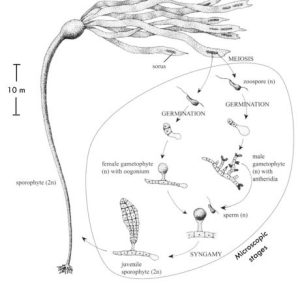
The complex and dynamic annual life cycle of kelp is keenly related to that of forage fish and salmon. In the summer months, overstory kelp forests create lush cathedrals of brown fronds and stipes; this added structures slow water, accumulate zooplankton, and provide refuge for fish communities (Duggins 1988).
Substrate type dictates the distribution of overstory kelp forests. Instead of a root system to anchor the buoyant overstory kelp to the seafloor, they have a ‘holdfast’ that resemble ‘fingers’ holding on for dear life. Without the holdfast, and a suitable anchor to ‘hold’ onto, kelp will float away. So, overstory kelp forests are not found along fine/sandy/cobble zones, they are found where there is a rocky substrate.

Biology and the Dynamic Life History of Forage Fish
Forage fish are the cornerstone of our cold-water coastal ecosystems. They are pelagic, schooling fish that seasonally migrate to nearshore coastal zones to spawn (Pentilla, 2007). Abundant and packed with protein, nutrients, and fatty acids, they are a critical food resource for everyone from salmon to whales.
Sand lance (Ammodytes personatus), surf smelt (Hypomesus pretiosus) and herring (Clupea pallasii) are a few of the most common forage fish of our cold-water coastal zones. All three of these forage fish species spawn along the nearshore. Sand lance and surf smelt spawn along intertidal zones of very specific grain size beaches at high tides. Sand lance prefer to lay their eggs in very sandy beaches, while surf smelt prefer a gravel beach with a small rough/rocky substrate to lay their eggs (Figure 3). The eggs will then mature for 11-16 days in the summer (longer in the winter) and then hatch in the nearshore at the mercy of the tides and wind (Pentilla 2007).
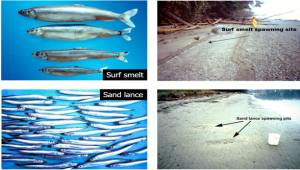
Herring spawning habits differ vastly from those of surf smelt and sand lance. Herring lay their eggs on *understory* kelp, red algae, and eelgrass in the nearshore. Herring spawning events can be dramatic and attract loud congregations of marine life that feed on the spawning fish and newly laid eggs. They can also include beautiful changes in the water color, called ‘white water’ events. Pictured below are white clouds and plumes in the water; this is milt that has been released by the male herring (Figure, 4).
While that’s going on, the female herring lays a carpet of eggs on eelgrass and understory vegetation below (Figure, 5). The eggs hatch in 10-12 days. Once hatched the forage fish larvae will grow and develop from larvae to juveniles as they rear, feed, and grow along nursing grounds of the nearshore, including along kelp forests. Eventually, these forage fish will fully mature and migrate to other deeper water habitats.
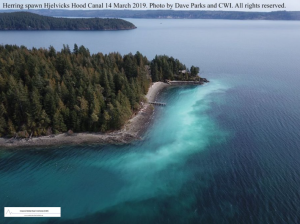
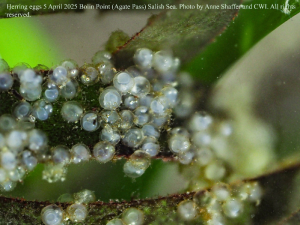
Biology and Dynamic Life History of Salmon
Salmon are a charismatic icon of our region and depend on the cold-water nearshore coastal zones. Like forage fish and kelp, sediment is also a key factor for salmon. Salmon spawn by laying their eggs in specific gravel areas of cold-water rivers of the northeast Pacific. If the right substrate is not available, spawning will not be successful. The eggs mature in these specific gravel zones for several weeks (depending on species and temperature) and then hatch during winter/early spring. After hatching, the baby salmon (also called ‘fry’) migrate downstream to the nearshore’s lower river zone, an essential nursery ground for juvenile salmon to transition into smolts.
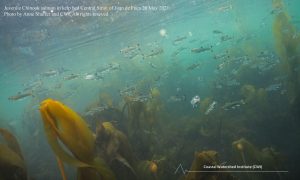
Depending on species and season, these baby salmon may spend a few months to a year transitioning back and forth from coastal shorelines, including estuaries and overstory kelp forests, to river systems. During the juvenile salmon’s time in the nearshore, they undergo a phylogenetic shift and learn to prey on forage fish (Figure. 8). Kelp forests are one of the places where these two guilds have their first interaction of a lifelong association.
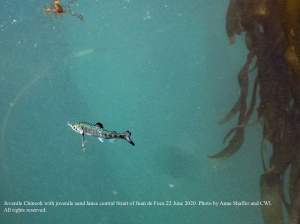
Intersection of the cold-water overstory kelp forests, salmon, and forage fish
Overstory kelp forests, salmon and forage fish each have very dynamic and complicated life histories. Ecological research at CWI has been identifying and understanding how these dynamic life histories converge and build on each other to produce high-functioning and healthy nearshore ecosystems.
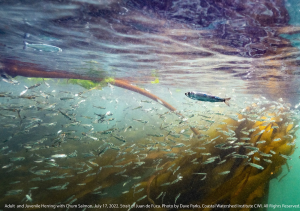
We know that overstory kelp forests are complex and change dramatically with season. They largely disappear in winter and reappear as lush forests in the spring/summer. At the same time, forage fish begin spawning in the nearshore on intertidal beaches and amongst understory kelp and eelgrass, young salmon are emerging from their gravel beds. Salmon and forage fish migrate off their respective natal grounds and arrive together to the overstory kelp forests just when the kelp reach the surface, providing structurally complex nursery habitats for young forage fish and salmon to grow, feed, and interact.

We know from years of work that not all overstory kelp forests function the same for salmon and forage fish; and that, when, where, and who all matter in overstory kelp ecosystem function (Shaffer et al 2023, 2020, 2019, 2012).
Finally in the fall salmon and forage fish migrate out of overstory kelp zones, the kelp senesce, release their holdfasts and float to shore creating large deep windrows of ‘beach wrack’ – another complex story for another blog! (Dugan et al 2003). These rich nutrient deposits are indispensable for species in the coastal zone, including migrating birds and fish (Figure 11 & 12).
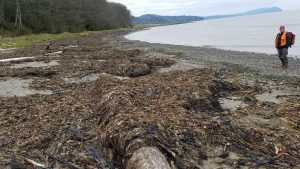

And in the Elwha…
The shoreline armoring along the Elwha drift cell and in-river dams have played a historic, significant role in the sediment starvation of the Elwha nearshore.
Overstory kelp forests of the Elwha Drift Cell
After the two dams were installed in the Elwha River at the turn of the century, the overstory kelp forest exploded along the Elwha drift cell. Why? Sediment starvation, due to sediment trapped behind the two dams.
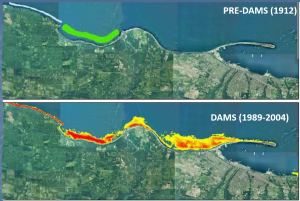
While these kelp forests were extensive, field surveys revealed that fish use of these kelp forests was not the same along all landforms they were found, and the ‘original’ embayed kelp forest shorelines were the most productive. (Shaffer et al. 2012)
With the dam removals, the sediment-starved Elwha drift cell received a gift of 100 years of sediment trapped behind the two dams. Approximately 10,000,000 cubic meters of sediment was delivered to the nearshore within 5 years of the dam removals (Warrick et al, 2019).
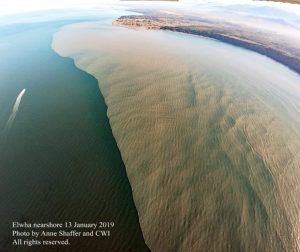
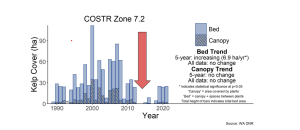
Forage Fish in the Elwha
In the Elwha nearshore herring, sand lance, and surf smelt are the most common species of forage fish (Frick et al., 2022). Armoring installed in the 1920s along the eastern beaches of the Elwha buried swaths of the beach and significantly disrupted hydrodynamic sediment processes, which in turn changed the beach composition to a steep, rocky habitat-benefiting kelp but disrupting sand lance, and surf smelt spawning (Shaffer et al., 2008).
Since the removal of the two dams, which ended in 2014, and the removal of 3,600 cubic yards of rip-rap/shoreline armoring from the east Elwha delta in 2016-2017, the sediment hydrodynamics of the Elwha delta and eastern feeder bluffs have been transformed (Warrick et al., 2019 & Parks et al., 2022). The beach at the restoration site *and up to six kilometers way* along this eastern reach of the drift cell has changed dramatically from a coarse, steep cobble beach to a broad, sandy and gravel beach. Surf smelt spawn distribution has responded and now extends along a much wider reach of the drift cell (CWI, 2022 & Shaffer et al., 2025).
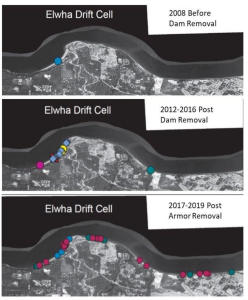
Conclusion
Overstory kelp forests, salmon, and forage fish are all physically linked to each other. Larger geographic, hydrodynamic, and water quality processes are physical and components that create healthy coastal zones for kelp forests, salmon, and forage fish and their complex and tightly timed interactions.. Disruption to these hydrodynamic processes, including thru shoreline development, in river dams, contaminants from storm water can disrupt kelp, salmon, and forage fish with clear ecological impacts. Restoring our coastal zones at an ecosystem scale can quickly bring back habitat forming processes and ecological function. But restoration actions are extremely expensive, take a long time, and are often incomplete.
Given the tightly intertwined roles of overstory kelp, forage fish, and salmon, it is clear that conservation of intact coastal ecosystem processes is critical to sustaining our coastal cold water systems, including overstory kelp forests, forage fish, and salmon.
Bibliography
Berry, H. 2011. Long term kelp mapping in the Elwha nearshore. Proceeding, 2011 Elwha nearshore. https://coastalwatershedinstitute.org/resources_25_3574329714.pdf
Coastal Watershed Institute (CWI). 2022. Elwha River Dam Removals: A Nearshore Synthesis a Decade After the World’s Largest Dam Removal Project. A CWI Technical Report. Coastal Watershed Institute Port Angeles, Washington. ISSN 092022:1. ISSN2643-9697/ https://coastalwatershedinstitute.org/wp-content/uploads/2023/03/Elwha-Nearshore-Synthesiscwisept2022techmemo-1.pdf
Dugan, J.E., Hubbard, D.M., McCrary, M.D. and Pierson, M.O., 2003. The response of macrofauna communities and shorebirds to macrophyte wrack subsidies on exposed sandy beaches of southern California. Estuarine, Coastal and Shelf Science, 58, pp.25-40.
Duggins, D.O., 1988. The effects of kelp forests on nearshore environments: biomass, detritus, and altered flow. In The community ecology of sea otters (pp. 192-201). Berlin, Heidelberg: Springer Berlin Heidelberg
Frick, K., Kagley, A., Fresh., K., Samhouri, J., Ward, L., Stapleton, J., Shelton, A. 2022. Spatiotemporal Variation in Distribution, Size, and Relative Abundance within a Salish Sea Nearshore Forage Fish Community Marine and Coastal Fisheries, Volume 14, Issue 2.
Penttila, D., 2007. Marine Forage Fishes in Puget Sound. Puget Sound Nearshore Partnership Report No. 2007-03. Seattle, Wash- ington: Seattle District, U.S. Army Corps of Engineers, 30p2022.
Shaffer, J.A. 2000. Seasonal variation in understory kelp bed habitats of the Strait of Juan de Fuca. Journal of Coastal Research. 16 (3) 768-775.
Shaffer, J.A., Crain, P., Winter, B., McHenry, M.L., Lear, C. and Randle, T.J., 2008. Nearshore restoration of the Elwha River through removal of the Elwha and Glines Canyon dams: an overview. Northwest Science, 82(sp1), pp.48-58.
Shaffer, A., Gross, J., Black, M., Kalagher, A. and Juanes, F., 2023. Dynamics of juvenile salmon and forage fishes in nearshore kelp forests. Aquatic Conservation: Marine and Freshwater Ecosystems, 33(8), pp.822-832.
Shaffer, J.A., Munsch, S.H. and Cordell, J.R., 2020. Kelp forest zooplankton, forage fishes, and juvenile salmonids of the northeast pacific nearshore. Marine and Coastal Fisheries, 12(1), pp.4-20.
Shaffer, J. A. and Parks, D.S.1994. Seasonal variations in and observations of landslide impacts on the algal composition of a Puget Sound nearshore kelp forest. Botanica Marina. 37: 315-323.
Shaffer, A., Parks, D. Schoen, E.R., and Beauchamp, D. 2019. Salmon, forage fish, and kelp. Frontiers in Ecology and the Environment, 17(5), pp.258-258.
Shaffer, JA., Crain, P., Kassler, T., Penttila, D., Barry, D. 2012. Geomorphic Habitat Type, Drift Cell, Forage Fish and Juvenile Salmon: Are They Linked? Journal of Environmental Science and Engineering A 1.
Shaffer, J.A., B. Oxborrow, D.S. Parks, D.G. Maucieri, and J. Michel. 2025. Linking Marine Ecosystem Response to Shoreline Armor Removal and Large Dam Removals in the Elwha River and Nearshore, Washington, USA. Journal of Coastal Research, 41(1), pp.1-15.
Warrick, J., Stevens, A., Miller, I., Harrison, S., Ritchie, A., Gelfenbaum, G. 2019. World’s largest dam removal reverses coastal erosion. Scientific Reports 9, Article no. 13968.
Washington state Deparment of Natural Resources (DNR) 2020. Kelp Forest Monitoring Alliance of Washington State. Kelp Distribution Map. https://wadnr.maps.arcgis.com/apps/webappviewer/index.html?id=f10864050bf14f57ba751ae53bc061f5